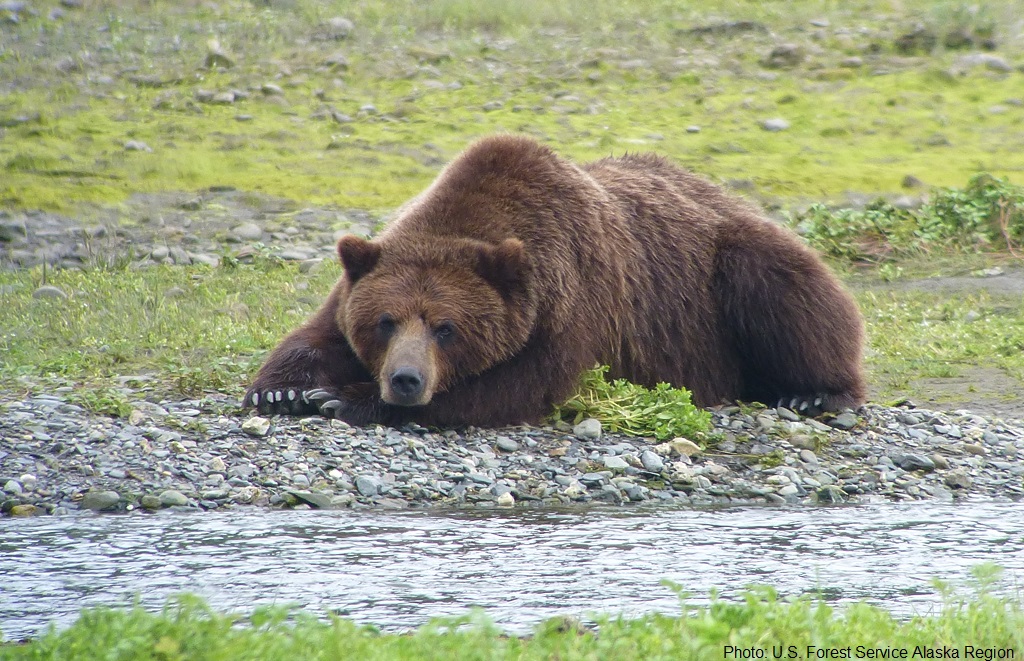Dispatch From The Field: A Trip Into Tongass Bear Country

In May, I was lucky enough to join our good friend Ken Leghorn on a recent trip to Pack Creek, located in the Kootznoowoo Wilderness on Admiralty Island. The name “Kootznoowoo” comes from the indigenous people of SE Alaska, the Tlingit, and means the “Bear Fort” or “Fortress of the Bears.” Ken owns and runs Pack Creek Bear Tours and takes folks out to see the huge coastal brown bears of the Tongass.
Brown bears in the Tongass rely in large part on salmon, which will soon be returning from the Pacific Ocean to the streams and watersheds of southeast Alaska to spawn. Salmon feed everything in the forest, but until they return, bears are busy munching on sedges (like a hearty, juicy grass) and digging out clams and roots. Ken and I started the day watching a couple females delicately flipping rocks with their long claws, prying open clams, or with their mouths full of green while lounging in a meadow. These wild bears tolerate the presence of people; as long as we respect the bears by staying on the same trails, they don’t bother us.
May is mating season for these bears. We were watching a young female laying in the grass when a big male emerged from the trees. We were between him and the female. Her attention was immediately focused on him, but he didn’t seem to notice her.
My expectation was that this mature male, with massively muscular shoulders and a rich dark coat, would pursue the young female, but after a few minutes she got up and walked right past us towards him instead. When she was within a few dozen yards she stopped and began to walk away, frequently looking over her shoulder, as if to invite him away from the prying eyes of us pesky humans.
Nothing. The male stayed put. This was a prime-time bear near the peak of his power. Though mature at around 7 years, a bear is usually in his early teens before he is able to rise high enough in the highly-structured social pecking order to mate.
We eventually lost sight of the big fellow, but he soon reappeared, this time in pursuit of a more mature female. She was a bear who would have the experience to successfully raise cubs, but unlike the young female sitting in the shadows at the meadow’s edge, she didn’t show the big bear any interest.
We watched this drama unfold for a few more moments, a drama that has been playing out in the wilderness of Alaska since the glaciers retreated.
At the end of our trip, as we walked along the beach to meet the bush plane, the wind was in my ears and the sun singed my cheeks. At that moment, with my small group of humans and the knowledge that there were some VERY big bears off somewhere in the woods nearby, I felt something deep and maybe even ancient. Our species grew up around bears, our fascination with them stretches back to cave paintings and myths that still resonate.
Pack Creek is an incredibly special place, and we have chosen to keep the entire network of streams, forest and mountains that surround it as Wilderness. Beyond Pack Creek, there are thousands of hidden salmon watersheds in the Tongass that are hugely important for bears just like the ones we watched on our trip. Attempts to reinvigorate industrial-scale logging and give away public lands in southeast Alaska threatens the opportunity to have an experience like the one I had. Whether it’s the Mendenhall Glacier, the Tracy Arm Fjord, or a bear-seeing tour on Admiralty on Island, the Tongass National Forest in Southeast Alaska is one of the most popular tourist destinations in the state – it is where America goes to see Alaska. The Forest Service needs to hear from all Americans that these opportunities matter.
How to get there: Call up Pack Creek Bear Tours in Juneau, Alaska. They will arrange an experienced guide, food, flight and permits with the U.S. Forest Service and Alaska Department of Fish and Game. Alaska Air and Delta Airlines offer daily non-stop jet service from Seattle in the summer. Pack Creek is a short 25-30 minute flight by float plane from Juneau.
When to go: May is excellent for observing foraging, and occasionally courtship behaviors. Mid-June tends to be slow as bears follow new growth vegetation up the mountains before returning in mid-July to feed on wild salmon for the rest of the summer.
How to speak up: Click here.

